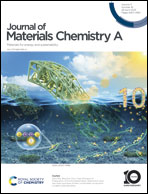Enhancing Li ion conduction through polyethylene glycol brushes towards long-life solid-state lithium metal batteries†
Abstract
Solid polymer electrolytes (SPEs) have attracted growing attention because of their good processability and nonflammability. However, their applications in solid-state batteries are restricted by their limited ionic mobility in the electrolyte bulk and at electrode/electrolyte interfaces. Herein, this issue can be effectively addressed by using a composite polymer electrolyte (CPE) consisting of a polyethylene (PE) separator with polyethylene glycol (PEG) brushes and SN-based electrolyte. The presence of PEG brushes effectively expedites Li+ diffusion but hinders TFSI− migration, which endows the PE-PEG CPE with an improved diffusion coefficient (DLi+, 2.50 × 10−13 m2 s−1) and a high Li+ transference number (tLi+, 0.69). Importantly, the PEG brushes act as “Li+ bridges” to allow Li+ to migrate through various interconnected interfaces in the whole battery. The solid-state LiFePO4‖Li batteries with PE-PEG CPE present excellent cycling stability over 1000 cycles at a high rate (3C). Pouch cells using the prepared CPE exhibit high specific capacity at 1C and superior safety. Our study offers an alternative solution toward the fabrication of SPEs with high Li+ transportability, which have potential application in high-energy-density solid-state batteries.



 Please wait while we load your content...
Please wait while we load your content...